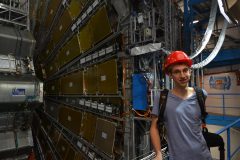By Susan Hickman
A Carleton University physics student who was involved in the discovery of the Higgs boson particle views his studies as “a long series of small victories.”
 Graham Cree, 27, who defended his PhD thesis in April, contributed significantly to Carleton’s ATLAS particle physics experiment at the Large Hadron Collider at the European Organization for Nuclear Research (CERN), part of the Higgs boson discovery.
Graham Cree, 27, who defended his PhD thesis in April, contributed significantly to Carleton’s ATLAS particle physics experiment at the Large Hadron Collider at the European Organization for Nuclear Research (CERN), part of the Higgs boson discovery.
Cree was always interested in physics and the fundamental laws of nature, he says, as is his older brother Warren, who plans to complete his master’s in Science at Carleton this summer.
After earning his Bachelor of Science degree at Carleton in 2011, Cree started his master’s and then fast-tracked to the PhD program in 2012. At first, he studied theoretical physics, but his “compelling professors really piqued my interest about particle physics as a field, such that I wanted to keep learning.”
He spent nearly a quarter of his graduate work onsite at CERN.
“The first time I went to CERN was in May 2012 and the discovery of the Higgs was announced in July. I was just learning how things work, but it was still very exciting to play a tiny role in that discovery.”
For his PhD, Cree developed a technique to more precisely measure the Higgs boson particle.
Reflecting on his experience, Cree says he acquired far more than physics knowledge.
“I have come out of it with a lot of experience in programming, data analysis and statistics. The gradual transition from being a new student in an analysis group to a significant contributor is something I am proud of. I went from the one asking questions to the one giving advice.”
Cree has been awarded the University Medal for outstanding achievement at the doctoral level. He graduated in June.
Wednesday, June 7, 2017 in Convocation, Grad Student Research
Share: Twitter, Facebook





